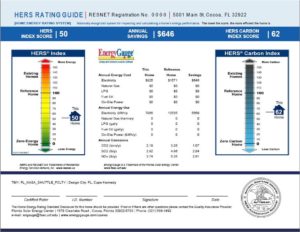RESNET’s new tool is called the CO2e Rating Index and is the first of its kind.

A building science expert with the FSEC Energy Research Center is part of a team that recently developed a first-of-its-kind tool that can calculate how much carbon dioxide buildings and homes produce.
“Climate change is a real problem, and the leading cause of it is carbon dioxide emissions,” says Philip Fairey, Deputy Director of FSEC, Florida’s premier energy research center at the University of Central Florida. “While the auto industry has made great strides in reducing carbon emissions from vehicles, the most well-known emitter of CO2, many people don’t know that buildings themselves are responsible for about 35% of greenhouse gas emissions due to burning fossil fuels for power, heating and cooling.”
Fairey is a board member of the Residential Energy Services Network, or RESNET, which created the tool. RESNET is a not-for-profit organization founded to develop a national market for home energy efficiency.
“With the nation’s climate goal of reducing U.S. emissions by half by the year 2030, it’s vital to have measurement tools to determine what causes these emissions and how to reduce them,” Fairey says. “That’s where RESNET comes in.”
RESNET’s new tool is called the CO2e Rating Index and is the first of its kind.
Fairey presented the CO2e Rating Index at the American Society of Heating, Refrigerating and Air-Conditioning Engineers International Building Decarbonization 2022 Conference on Oct. 5, in Athens, Greece.
Previously, RESNET established what is known as the Home Energy Rating System, or HERS, Index, which is a measurement that allows for easy comparison of energy performance of homes.
Similar to a miles-per-gallon decal for automobiles, the HERS Index provides the consumer information on how energy efficient their home is compared to other homes.
While the HERS Index is valuable in determining energy efficiency and showing how renewable energy is more beneficial than energy obtained from fossil fuels, there haven’t been any tools to show the effectiveness of building decarbonization.

The tool will be used by trained specialized home raters to rate homes along with the current HERS tool rating index.
“While the HERS Index is based on total annual energy consumption, we realized we couldn’t use the same process to evaluate CO2 emissions because utilities produce carbon at different intensities and different times of the day and the year,” Fairey says.
“Weather conditions greatly affect CO2 emissions, and the CO2e index software allows us to evaluate these different conditions during different times of the day and different months of the year to gain an accurate estimate of carbon emissions,” he says. “And since the emissions produced by electricity generation are expected to decrease over time as power generation becomes cleaner, the long-term generation emissions are more consequential than the short-term emissions.”
The new RESNET CO2 Rating Index will allow researchers to calculate energy efficiency on a whole new level, Fairey says.
For example, they can calculate and compare the emissions of two houses. By looking at one house using renewable energy and one that is not energy-efficient, they can produce estimates showing how much renewable electrification can reduce carbon emissions on a day-by-day basis.
Another benefit of the CO2 Rating Index is that researchers can now show that carbon emissions are directly dependent on when electricity is being used and is also affected by weather and other conditions, Fairey says.
This would allow for the implementation of energy efficiency measures, such as programming a heat pump water heater to raise water storage temperatures during “green time,” when carbon emissions are at the lowest, or reduce the heating during “red time,” when emissions are at the highest, the researcher says.
He says the tool can also work directly with the efforts being made by the auto industry for their goal of reducing carbon emissions by implementing the best times to charge an electric vehicle that would result in less CO2 emissions.
“With a future goal of zero-emissions and knowing that we need to greatly reduce our carbon footprint in order to improve the conditions of the planet we live on, the development and use of tools such as the HERS Index and the CO2e Rating Index will make great strides in optimizing residential buildings and other energy-consuming structures to allow for minimal greenhouse gas emissions,” Fairey says.
PR22-15